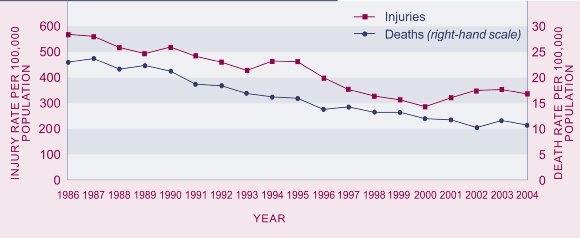Road casualties
Definition
The number of people killed or injured in motor vehicle crashes as a proportion (per 100,000) of the total population.
Relevance
Road deaths are a major cause of premature death, especially among young adults. Deaths, injuries and disability resulting from motor vehicle crashes inflict considerable pain and suffering on individuals, families and communities, as well as on other road users, emergency service providers, health workers and others.
Current level and trends
In 2004, 436 people died as a result of motor vehicle crashes, a rate of 10.7 deaths per 100,000 population.84 A further 13,814 people were injured, a rate of 340.1 injuries per 100,000 population. Deaths and injuries from motor vehicle crashes have declined substantially since 1986, when the rates were 23.1 and 569.6 per 100,000 respectively. The number of people killed in motor vehicle crashes was 43 percent lower in 2004 than it was in 1986. Although the number of people injured has risen since 2000, there were 27 percent fewer people injured in 2004 than in 1986.
There is no conclusive evidence on the reasons for the reduction in road casualties since 1986, but better roads and better vehicles, as well as legislation, enforcement and education aimed at reducing road casualties, may have contributed to an improvement in drivers' attitudes and behaviour.
Figure SS4.1 Road traffic injury and death rates, 1986-2004

Source: Land Transport Safety Authority (2004) Table 1
Note: Injury data is provisional
Age and sex differences
Young people aged 15–24 years are at a far higher risk of injury or death from motor vehicle crashes than any other age group, with death and injury rates more than double those of the population as a whole (23 deaths and 752 injuries per 100,000 in 2004). The risk of dying is relatively low in middle age, then increases sharply at older ages, partly because of increasing fragility among the very old.
Males are much more likely than females to be injured or killed in motor vehicle crashes. In 2004, the injury rate was 390 per 100,000 for males and 286 per 100,000 for females; the death rate was 14.6 per 100,000 for males and 7.0 per 100,000 for females.
Table SS4.1 Road casualty rates, by age and sex, 2004
| |
Rate per 100,000 population in each group |
| |
Reported injury rate |
Death rate |
| Age |
Males |
Females |
Total |
Males |
Females |
Total |
| Under 15 |
142.5 |
96.6 |
121.2 |
3.1 |
2.6 |
2.8 |
| 15-24 |
875.1 |
621.2 |
752.3 |
30.7 |
15.3 |
23.2 |
| 25-34 |
512.9 |
335.2 |
422.6 |
15.2 |
6.8 |
10.8 |
| 35-44 |
374.3 |
268.0 |
319.9 |
14.9 |
4.0 |
9.3 |
| 45-54 |
297.0 |
236.6 |
267.5 |
10.2 |
5.5 |
7.8 |
| 55-64 |
248.0 |
204.3 |
226.5 |
13.6 |
7.9 |
10.7 |
| 65-74 |
208.8 |
210.7 |
211.0 |
13.6 |
8.2 |
10.8 |
| 75+ |
247.0 |
204.2 |
221.2 |
23.4 |
8.8 |
14.6 |
| Total |
390.3 |
286.0 |
340.1 |
14.6 |
7.0 |
10.7 |
Source: Land Transport Safety Authority (2004)
Note: Injury data is provisional
Ethnic differences
Māori are much more likely than other ethnic groups to die in motor accidents, with an age-standardised death rate of 22 per 100,000 in 2000. In comparison, the death rate for European and "Other" ethnic groups was 11 per 100,000 in 2000 and for Pacific peoples, 12 per 100,000. Because of a change in the classification of injury deaths, 2000 data is not comparable with earlier years.
Table SS4.2 Land transport accident death rates, by ethnicity, 1996–2000
| |
Age-standardised rate per 100,000 |
| Year |
Māori |
Pacific
peoples |
European
and Other |
Total |
| 1996 |
26 |
14 |
12 |
14 |
| 1997 |
25 |
10 |
12 |
14 |
| 1998 |
21 |
12 |
12 |
13 |
| 1999 |
19 |
8 |
12 |
13 |
| 2000 |
22 |
12 |
11 |
13 |
Source: Morris et al (2003)
Māori and Pacific peoples are less likely to drive than Europeans, but they are at a greater risk of injury and death from motor vehicle crashes. A 1998 survey showed that, per distance driven, the risk of being hospitalised as a result of a crash was more than three times as high for Māori drivers, and only slightly less than three times as high for Pacific drivers, compared to Europeans. 85
International comparison
In 2002, New Zealand was ranked 14th among 28 OECD countries with a road death rate of 10.3 per 100,000 people.86 This was below the OECD median of 11.3 deaths per 100,000. Sweden and the United Kingdom had the best outcomes in the OECD in 2002, each with a road death rate of 6.0 per 100,000. The New Zealand road death rate was better than that of the United States at 14.9 per 100,000 but worse than those of Canada at 9.3, and Australia at 8.7.
|

